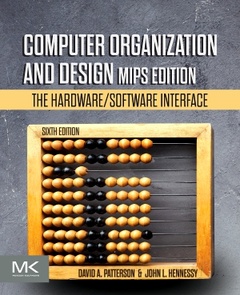Description
Computer Organization and Design MIPS Edition (6th Ed.)
The Hardware/Software Interface
The Morgan Kaufmann Series in Computer Architecture and Design Series
Authors: Patterson David A., Hennessy John L.
Language: English
Subject for Computer Organization and Design MIPS Edition:
Keywords
system design; processor; parallel; cloud; mobile; gpu; memory; instruction set; client; digital design; logic; operations; multiprocessor; pipelining; hardware; software; cluster; network; computer arithmetic<; I>; <; /I>
Approximative price 99.33 €
In Print (Delivery period: 14 days).
Add to cart800 p. · 19.1x23.5 cm · Paperback
Description
/li>Contents
/li>Readership
/li>Biography
/li>
- Winner of a 2014 Texty Award from the Text and Academic Authors Association
- Covers parallelism in depth with examples and content highlighting parallel hardware and software topics
- Includes new sections in each chapter on Domain Specific Architectures (DSA)
- Discusses and highlights the "Eight Great Ideas" of computer architecture: Performance via Parallelism; Performance via Pipelining; Performance via Prediction; Design for Moore's Law; Hierarchy of Memories; Abstraction to Simplify Design; Make the Common Case Fast; and Dependability via Redundancy
- Includes updates of all the real-world examples in the book
1. Computer Abstractions and Technology 2. Instructions: Language of the Computer 3. Arithmetic for Computers 4. The Processor 5. Large and Fast: Exploiting Memory Hierarchy 6. Parallel Processors from Client to Cloud
Appendix A. Assemblers, Linkers, and the SPIM Simulator B. The Basics of Logic Design C. Graphics and Computing GPUs D. Mapping Control to Hardware; APP E A Survey of RISC Architectures for Desktop, Server, and Embedded Computers
Undergraduate electrical engineering, computer engineering or computer science students taking a computer organization/computer architecture or computer design course; Professional digital system designers, programmers, application developers, and system software developers.
ACM named John L. Hennessy a recipient of the 2017 ACM A.M. Turing Award for pioneering a systematic, quantitative approach to the design and evaluation of computer architectures with enduring impact on the microprocessor industry. John L. Hennessy is a Professor of Electrical Engineering and Computer Science at Stanford University, where he has been a member of the faculty since 1977 and was, from 2000 to 2016, its tenth President. Prof. Hennessy is a Fellow of the IEEE and ACM; a member of the National Academy of Engineering, the National Academy of Science, and the American Philos
These books may interest you

Essentials of Computer Architecture 105.47 €



